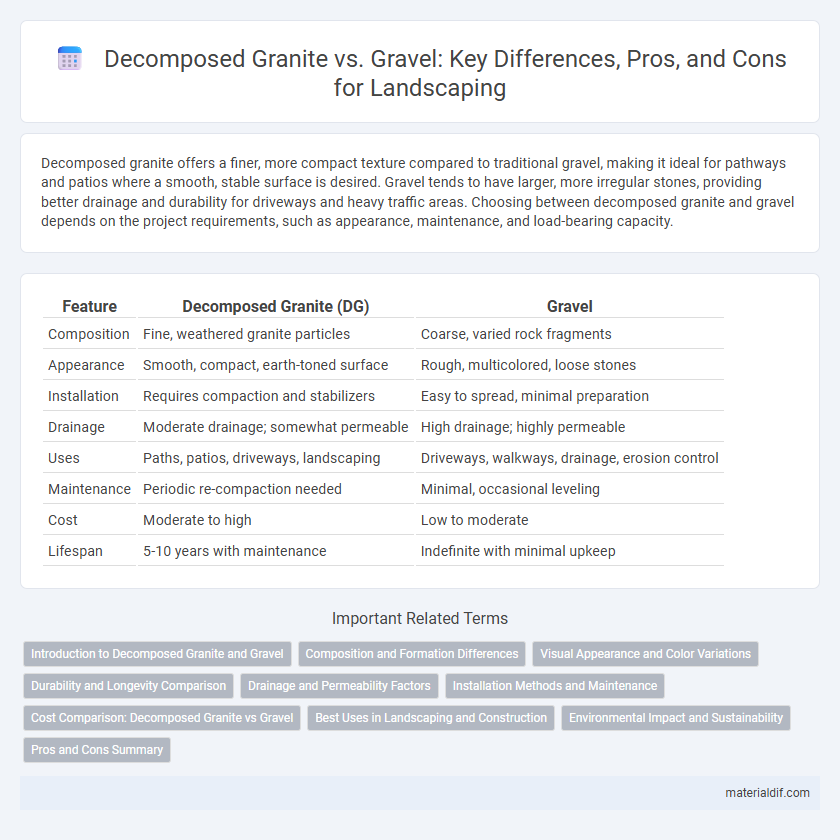Decomposed granite offers a finer, more compact texture compared to traditional gravel, making it ideal for pathways and patios where a smooth, stable surface is desired. Gravel tends to have larger, more irregular stones, providing better drainage and durability for driveways and heavy traffic areas. Choosing between decomposed granite and gravel depends on the project requirements, such as appearance, maintenance, and load-bearing capacity.
Table of Comparison
| Feature | Decomposed Granite (DG) | Gravel |
|---|---|---|
| Composition | Fine, weathered granite particles | Coarse, varied rock fragments |
| Appearance | Smooth, compact, earth-toned surface | Rough, multicolored, loose stones |
| Installation | Requires compaction and stabilizers | Easy to spread, minimal preparation |
| Drainage | Moderate drainage; somewhat permeable | High drainage; highly permeable |
| Uses | Paths, patios, driveways, landscaping | Driveways, walkways, drainage, erosion control |
| Maintenance | Periodic re-compaction needed | Minimal, occasional leveling |
| Cost | Moderate to high | Low to moderate |
| Lifespan | 5-10 years with maintenance | Indefinite with minimal upkeep |
Introduction to Decomposed Granite and Gravel
Decomposed granite is a naturally weathered rock material that breaks down into small particles resembling coarse sand, offering a smooth, compact surface ideal for pathways and landscaping. Gravel consists of larger, rounded rock fragments that provide excellent drainage and stability, commonly used for driveways and construction bases. Both materials vary in texture, durability, and aesthetic appeal, making them suitable for different outdoor applications depending on functional and design requirements.
Composition and Formation Differences
Decomposed granite consists of weathered granite that breaks down into smaller particles over time, creating a natural, earthy material with fine granules and occasional larger fragments. Gravel typically forms from various rock types, including limestone, quartz, or basalt, and is mechanically crushed or naturally eroded into rounded, coarse aggregates. The key difference lies in decomposed granite's finer, sandy texture derived from granite's mineral content, while gravel is composed of diverse rock fragments with varying hardness and sizes.
Visual Appearance and Color Variations
Decomposed granite features a finer, more uniform texture with natural earth tones such as reddish-browns, golds, and taupes, offering a smoother and compact appearance. Gravel displays a wider range of sizes and shapes with more varied colors, including grays, whites, black, and sometimes multicolored speckles, creating a rougher and more casual look. The choice between decomposed granite and gravel depends on desired visual impact, with decomposed granite providing a cohesive, subtle palette and gravel allowing for bolder, more diverse color variations.
Durability and Longevity Comparison
Decomposed granite offers moderate durability but tends to break down and wash away over time, requiring regular maintenance, whereas gravel is highly durable, resistant to weathering, and maintains its structural integrity for decades. Gravel's angular particles interlock, providing superior longevity and stability for high-traffic areas compared to the softer, more fragile composition of decomposed granite. For long-term projects needing minimal upkeep, gravel is a more resilient and lasting surface material.
Drainage and Permeability Factors
Decomposed granite offers superior drainage and permeability due to its fine, compactable particles that allow water to pass through quickly while reducing erosion. Gravel consists of larger, coarser stones creating more gaps, which enhances water flow but may cause instability if not properly contained. Both materials provide effective drainage solutions, yet decomposed granite's denser composition makes it preferable for pathways needing firm, stable surfaces with efficient water runoff.
Installation Methods and Maintenance
Decomposed granite installation involves spreading and compacting fine granules to create a stable, natural-looking surface that requires occasional raking and replenishing to maintain its texture and prevent erosion. Gravel installation typically uses a compacted base layer with larger, loose stones that provide excellent drainage but demand regular raking to manage displacement and periodic topping up to sustain depth. Both materials benefit from edging to contain their spread, but decomposed granite offers a smoother finish ideal for pathways, while gravel suits driveways and drainage areas due to its robust, permeable structure.
Cost Comparison: Decomposed Granite vs Gravel
Decomposed granite typically costs between $3 to $5 per square foot, while gravel generally ranges from $1 to $3 per square foot, making gravel the more budget-friendly option for large areas. Installation expenses for decomposed granite can be higher due to the need for proper compaction and edging to maintain stability. Maintenance costs for both materials are relatively low, but decomposed granite may require occasional replenishing to prevent erosion.
Best Uses in Landscaping and Construction
Decomposed granite offers a fine, compactable texture ideal for pathways, patios, and erosion control, providing a stable surface that blends naturally with landscapes. Gravel, with its larger, angular stones, excels in drainage applications, driveways, and as a base material in construction projects requiring strong support and water runoff management. Both materials enhance landscape aesthetics and functionality, but decomposed granite suits low-traffic areas while gravel withstands heavier loads and high-traffic zones.
Environmental Impact and Sustainability
Decomposed granite offers a more sustainable option than traditional gravel due to its natural composition and permeability, reducing runoff and promoting groundwater recharge. Gravel mining can cause significant environmental disruption, including habitat destruction and increased sedimentation in waterways. Choosing decomposed granite supports eco-friendly landscaping by minimizing soil erosion and leveraging a material closer to its natural state.
Pros and Cons Summary
Decomposed granite offers a natural appearance with excellent compaction, making it ideal for pathways and patios, but it can erode or wash away in heavy rain. Gravel provides superior drainage and durability for driveways and long-term use but may shift and require periodic replenishing. Both materials differ in maintenance needs and cost, with gravel generally being more affordable, whereas decomposed granite offers a smoother surface for walking.
Decomposed Granite vs Gravel Infographic

 materialdif.com
materialdif.com